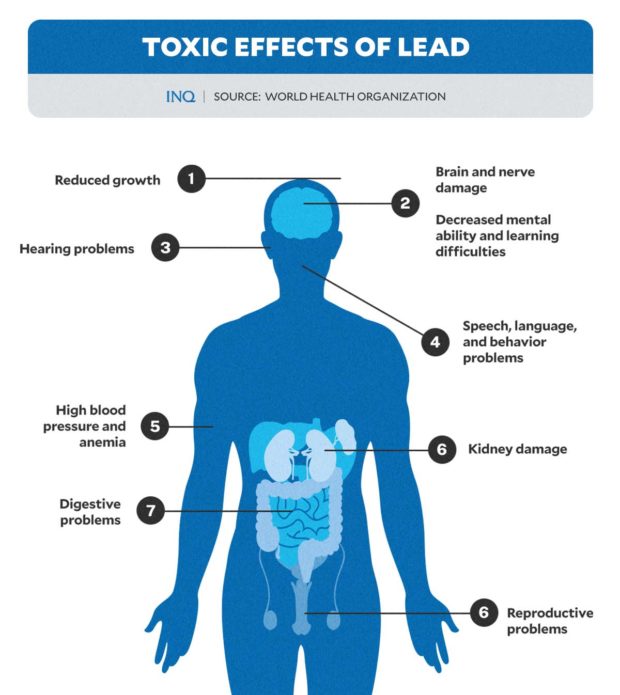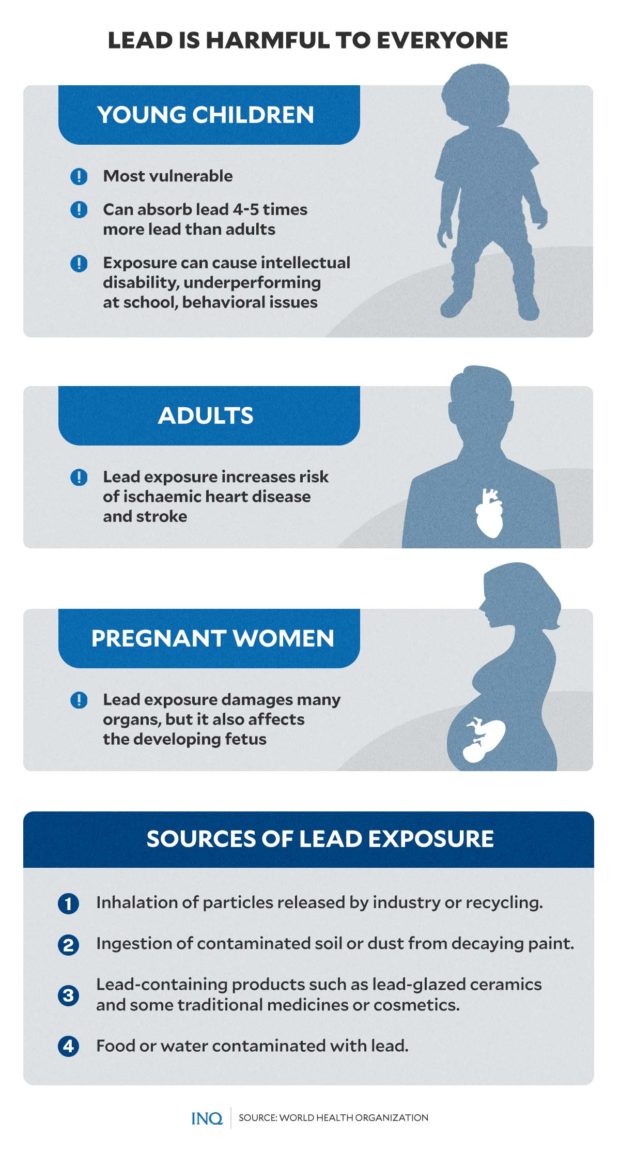International Lead Poisoning Prevention Week: The harm everyone faces
MANILA, Philippines—In observation of the International Lead Poisoning Prevention Week (ILPPW) this year, the World Health Organization (WHO) reminds governments, civil society organizations, health partners, and industries across the globe of the unacceptable risks of lead exposure and the need for action.
Throughout the years, the widespread processing, use, and disposal of lead—a naturally occurring toxic metal—has led to extensive environmental contamination, human exposure, and significant public health problems worldwide.
Lead, according to WHO, has many uses, “including in the manufacture of lead-acid batteries for motor vehicles and energy storage, in pigments and paints, solder, ammunition, ceramic glazes, jewelry, toys and also in some cosmetics and traditional medicines.”
WHO said that lead poisoning or excessive human exposure to lead remains one of the biggest health-related problems in many countries.
“Lead is a potent neurological and cardiovascular toxicant that is responsible for nearly 1.5 percent of annual global deaths (900,000). That is almost as many deaths as a result from HIV/AIDS (954,000), and more than from malaria (620,000), war and terrorism (150,000) or natural disasters (90,000),” Unicef and Pure Earth said in a report released in 2020.
Article continues after this advertisement“However, annual deaths capture only a small slice of lead’s true impacts,” the report noted.
Article continues after this advertisementToxic effects of lead
Lead is harmful to everyone, according to WHO. When a person is exposed to lead, it is distributed to the brain, liver, kidney, and bones. It is also stored in the teeth and bones, where it accumulates over time
Lead can affect multiple body systems, including the neurological, hematological, gastrointestinal, cardiovascular, immune, and renal systems.
Among the toxic effects of lead on the human body include:
- brain and nerve damage
- decreased mental ability and learning difficulties
- hearing problems
- speech, language, and behavior problems
- anemia
- high blood pressure
- kidney damage
- reduced growth
- digestive problems
- reproductive problems
Exposure to lead also increases the risk of ischaemic heart disease and stroke among adults.
WHO also noted that lead in bone is released into the blood during pregnancy and becomes a source of exposure to the developing fetus.
Lead poisoning in children
While it can cause chronic and debilitating health impacts in all age groups, lead can be particularly harmful to younger children. Their developing nervous system, WHO said, is vulnerable to the toxic effects of lead, even at levels of exposure that do not cause obvious symptoms and signs.
“Lead exposure can have serious consequences for the health of children. At high levels of exposure, lead attacks the brain and central nervous system, causing coma, convulsions, and even death,” WHO said.
“Children who survive severe lead poisoning may be left with intellectual disability and behavioral disorders,” it added.
Lead can affect children’s brain development which results in reduced IQ, behavioral changes—such as reduced attention span and increased antisocial behavior—and reduced educational attainment.
The neurological and behavioral effects of lead, WHO stressed, are believed to be irreversible.
It could also cause anemia, hypertension, renal impairment, immunotoxicity, and toxicity to the reproductive organs.
“There is no known safe blood lead concentration; even blood lead concentrations as low as 3.5 µg/dL may be associated with decreased intelligence in children, behavioral difficulties, and learning problems,” WHO explained.
“As lead exposure increases, the range and severity of symptoms and effects also increase.”
Data from Unicef and Pure Earth’s report, titled “The Toxic Truth: Children’s Exposure to Lead Pollution Undermines a Generation of Future Potential”, showed that as of 2019, the number of children (ages 0-19) with blood levels above 5 µg/dL in different regions are as follows:
- South Asia: 378,651,188
- East Asia and Pacific: 77,675,947
- West and Central Africa: 139,373,360
- Eastern and Southern Africa: 93,109,913
- Middle East and North Africa: 63,441,649
- Eastern Europe and Central Asia: 10,027,028
- Latin America and Caribbean: 49,107,507
- North America: 1,359,412
- Western Europe: 2,474,105
- Sub-Saharan Africa: 232,483,273
- Europe and Central Asia: 12,501,133
In the Philippines, it was estimated that 20 million children, or at least 50 percent, have blood levels above 5 µg/dL—“ranking the country in the world’s top 20 number of children lead poisoned,” said nonprofit organization Pure Earth.
Lead paint found in PH
There are different possible sources of lead exposure, including:
- Inhalation of particles released by industry or recycling.
- Ingestion of contaminated soil or dust from decaying paint.
- Lead-containing products like lead-glazed ceramics and some traditional medicines or cosmetics.
- Food or water contaminated with lead.
Lead, according to EcoWaste Coalition and the International Pollutants Elimination Network (IPEN), can also be found at higher levels in “solvent-based paints when it is intentionally added to the paint to give it a color, to facilitate the drying process, or used as a pigment to inhibit rust or corrosion.”
“A paint may also contain some amount of lead when raw materials contaminated with lead are used, or when there is cross-contamination from other product lines in the same factory.”
In a report released this month, the EcoWaste Coalition and IPEN found that despite a national ban on lead-containing paints to protect children, women, and workers from the harmful effects of lead exposure, such products exported from China and Thailand still enter the country.
From September 2020 to September this year, the group collected 100 samples of aerosol paints or spray paints sold by online vendors and general merchandise, hardware, home improvement, motorcycle, and school supply stores in 15 cities.
Analysis of the samples found that “85 of the 100 spray paints representing 25 brands surpassed the 90 ppm total lead limit, of which 69 spray paints contained extremely high lead concentrations above 10,000 ppm.”
“Despite the ban, imported lead-containing spray paints are still able to enter our ports and sold with impunity. This illegal trade infringes on our right to a clean, healthy and sustainable environment, a human right recognized by the UN General Assembly last July,” Aileen Lucero, National Coordinator, EcoWaste Coalition, said in a statement.
“This situation should prompt the authorities to ramp up new initiatives to enforce the ban on lead paints, including nominating lead chromates, the most common lead-based paint pigments, for listing under the Rotterdam Convention in order to control the entry of such raw materials and the finished paint products containing them,” said Manny Calonzo, adviser, EcoWaste Coalition.
Through Department of Environment and Natural Resources (DENR) Administrative Order 2013-24, also known as the Chemical Control Order for Lead and Lead Compounds (or the CCO), the Philippines established a total lead limit of 90 ppm for lead used as pigment, drying agent or for some other intentional purposes in paint formulations.
EcoWaste Coalition and IPEN said the CCO set a phaseout deadline of three years (2013-2016) for lead-containing paints used for architectural, decorative, and household applications and six years (2013-2019) for lead-containing paints used for industrial applications.
Last year, the country was awarded the Future Policy Award by the World Future Council (WFC) for being the first in Southeast Asia to successfully implement legislation toward the elimination of all lead-containing paints.
READ: Philippines recognized for banning lead in paints
What to do?
EcoWaste Coalition and IPEN recommended different government agencies to impose fines, penalties, and criminal cases against manufacturers, importers, distributors, and retailers of lead-containing paint products that are wrongfully labeled as “lead-free” “in line with Republic Act 7394 or the Consumer Act of the Philippines.”
WHO reminded the public to be careful consumers.
“You should try to become informed about sources of lead exposure in your community and avoid buying products that may contain lead. For example, check the label when buying paint to see if lead is mentioned,” WHO said.
“If you are not sure ask the vendor or the manufacturer about possible lead content. If you know that lead paint is not legally controlled in your country, lobby your politicians to do something about it,” it added.



